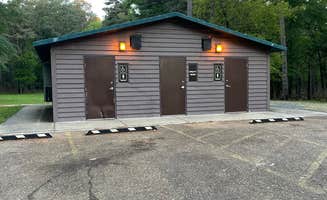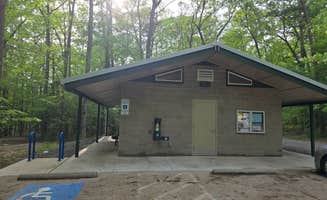Situated in the northeastern corner of Texas near the Arkansas border, Texarkana sits at an elevation of about 300 feet with humid subtropical climate conditions. Summer temperatures regularly exceed 90°F with high humidity, while winters remain relatively mild. Several campgrounds in the region offer glamping accommodations with varying levels of luxury and amenities beyond standard RV hookups.
What to do
Fishing opportunities: Atlanta State Park Campground provides excellent fishing access on Wright Patman Lake. "Wright Patman Lake is a decent lake, but does have a fair amount of stumps along the edges- watch for the bouyees. Fishing is good, water can get very warm in the summer which is nice for swimming," notes one experienced visitor.
Diamond hunting: Crater of Diamonds State Park Campground offers a unique experience where visitors can search for and keep any diamonds found. "The Crater of Diamonds State Park is an exciting place full of rich history and, of course, finding lots of rough diamonds," writes a camper. The park provides equipment rentals, though the field can get extremely hot in summer with minimal shade.
Water recreation: Several glamping sites in Texarkana provide access to lakes and ponds. "Great place to swim, boat kayaking and fishing!" mentions a visitor to Atlanta State Park. The park features multiple swimming areas with beaches along with two boat ramps in good condition.
What campers like
Private bathrooms: Texarkana RV Park & Event Center receives praise for its bathroom facilities. "We did take a shower in the morning and they have great bathrooms. They are large and extremely well taken care of. The shower, sink and toilet are all in one locked room," reports one camper who specifically mentioned stopping there for the quality of facilities.
Security features: Some luxury glamping sites offer additional security measures. One reviewer notes that Texarkana RV Park has "a gated entrance for extra security," though another visitor mentioned finding "the gate is broken and doesn't close" during their stay.
Level sites: Murfeesboro RV Park provides well-maintained, level camping spots. "The sites were well maintained and spaced nicely," notes a satisfied visitor, while another camper appreciated that this campground offers affordable tent sites with electrical hookups.
What you should know
Weather impacts: Heavy rain affects camping conditions at several sites. At the diamond hunting field, "rains cause the soil to cake up on shoes and make it difficult to walk in the field," warns an experienced visitor. Plan your glamping trip accordingly, especially if outdoor activities are your priority.
Train noise: At Forest Lake RV Park, guests should be prepared for possible noise disruption. One camper reports "Very loud and very close train nearby" despite the beautiful grounds and fishing pond at this glamping destination.
Limited site options: Some campgrounds have restricted availability for specific hookups. At Atlanta State Park, a visitor noted "the limited amount of full hookups and then only 1 dump station" as the main downside of an otherwise clean and well-maintained park.
Odor issues: Some areas around Texarkana have environmental odor problems. A Forest Lake visitor mentioned, "this area smells really bad," though they clarified this wasn't the park's fault specifically.
Tips for camping with families
Swimming options: The water features at White Cliffs Park make it ideal for families seeking water recreation. "Clean park, clean bathrooms, level pad," noted one visitor about the park's facilities, which complement the waterfront location.
Diamond hunting timing: When planning a glamping trip that includes diamond hunting, consider the season. "Winter, Spring and Fall are the best seasons to visit. The diamond field is a large, unshaded field," advises a visitor to Crater of Diamonds State Park.
Playground access: Several parks offer play equipment for children. A reviewer observed that Atlanta State Park is "meticulously maintained with several hiking trails," which combined with playground areas makes it suitable for families with children of various ages.
Bug preparation: When glamping near Texarkana's wooded areas, insect protection is essential. "I would recommend bringing a citronella candle there were a lot of bugs at night," suggests a camper who stayed at Atlanta State Park, adding that summer months typically have more insect activity.
Tips from RVers
Site selection challenges: Some RV spots have accessibility issues. A camper at Texarkana RV Park noted, "We drove in this time with a longer rental unit with a trailer attached and found ourselves in a couple of tough turns trying to get to our spot. Wider lanes and intersections would be appreciated."
Slide-out considerations: When setting up at glamping sites with RV pads, be cautious about positioning. One reviewer warns, "Beware of your slide placement before parking, as site poles may be in the way of a slide fully opening" at Texarkana RV Park.
Stabilizer requirements: Prepare for uneven terrain at some sites. "Sites are pretty good size with table, grill and fire ring. Pads are fairly level, only took 1 2x12 in the one side, make sure to bring blocks for the rear stabilizers as the pad drops off at the back," advises an RVer at Atlanta State Park.




